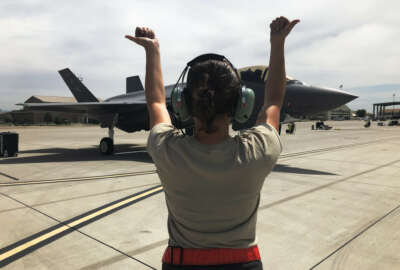The Defense Department is urged to get a better handle on its tactical aircraft investments
Fighter plans and attack planes are known as tactical aircraft. The armed services have a lot of them, mostly old. So old, most of them are past their services ...
Fighter plans and attack planes are known as tactical aircraft. The armed services have a lot of them, mostly old. So old, most of them are past their services lives. Yet they are still in the inventory and the Defense Department wants to spend a hundred billion dollars to refresh the fleet. The Government Accountability Office finds, DoD needs more detailed analysis before proceeding. To explore the details, the Federal Drive with Tom Temin spoke with Marie Mak, GAO’s Director of Contracting and National Security Acquisitions Issues.
Interview transcript:
Marie Mak
When it comes to exact numbers, I won’t go there just because some of it’s probably more classified than not. But when it comes to aircraft capabilities, I think one of the challenges the department faces is how best to modernize. How much do you invest in the development of more advanced capabilities, and procurement of new aircraft versus sustaining those that are currently in operational use? And like you said, it becomes a very difficult balance because Department of Defense is existing tactical aircraft have been operational since the 70s and 80s, and are very old.Tom Temin
We’re basically talking F-15, F-16, F-18, F-22.Marie Mak
Correct. And let me put it from an acquisition perspective, because that’s where I’ve done a lot of the work. And we typically find that in hopes of meeting capability needs more quickly, DoD historically initiates new acquisitions with limited knowledge about key technologies and system designs. And then we consistently find that this approach leads to cost overruns, scheduled delays and ultimately performance issues. So this approach gets back to that difficult balancing act I mentioned earlier, and it drives DoD to invest billions of dollars in service life extensions, and sustainment efforts to address shortfalls and enhances existing capabilities. Getting back to what you mentioned in terms of the aircraft. Take a look at the F-35. For example, development began in 2001. Within mature technologies, it resulted in numerous development challenges, cost overruns, and delays most likely to warfighting capability. More than two decades later, DoD is still chasing that modernization of capabilities. So as a result, DoD has modernized and has continued to modernize and extend the service lives of older aircraft like the F-15, F-16, F-18, just to ensure that we have the aircraft with some level of useful capability in the event that we really need those kind of capabilities operationally.Tom Temin
All right. So there are a lot of planes, I’m guessing it’s the hundreds, it could even be thousands of these and Air Force and Navy, and so on. Then they have the choice of what to do with them as individual aircraft are some of them ready to just be scrapped. They’re beyond updating, and others can be updated and kept going, or what’s that situation?Marie Mak
And that’s really where we looked at what DoD studied to find out first, are there really gaps and shortfalls? And we looked at these DoD studies which have done really well, because they use the assumption of affordability constraints when they looked at the tactical aircraft. And these studies were done between January 2020, and 2022. And bottom line is, depending on the assumptions are used, which timeframes, which threat you’re dealing with, the basic conclusion is that we need to modernize the tactical aircraft fleet. That’s essential. But as you mentioned earlier, in terms of how do they address this, there’s over $20 billion spent annually for combined Air Force and Navy, just to procure aircraft and modernize the existing aircraft. It’s that delicate balance that we referred to earlier. About what do you get rid of? What do you build on? And where do you buy new ones?Tom Temin
Right, because at some point, theoretically, a given aircraft can be kept going forever. If you put enough money into it, at some point it becomes uneconomic even though it’s technically possible to fly it forever.Marie Mak
You also want to look at capabilities, what are the future capabilities we need? I mean, these older aircraft are still very capable. I don’t honestly, I don’t want to imply that they’re not capable to do what we need. But longer term, it’s one of those do we have the aircraft to address the capabilities that we need to the future fight That’s really what’s important. We have to make sure that is there.Tom Temin
And I want to get to your recommendations. We’re speaking with Marie Mak director of contracting and national security acquisitions issues at the Government Accountability Office. And in this particular report, you’re really looking at the analytics that DoD has to do to make sound decisions. Correct?Marie Mak
Right. And what we found is that the military services they are making investment decisions to address their respective tactical aircraft needs. The problem is as a department as a whole, has not conducted an integrated portfolio level analysis across tactical aircraft investments. For instance, like we discussed earlier, Air Force and Navy combined invest an average of $20 billion annually over the next several years on tactical aircraft addressing shortfalls and gaps, but it’s their own individual service gaps. And ultimately that’s not how we fight, DoD fights as a joint force. And granted the budgets for and acquire systems are all individual. And so the system is very service driven, stovepipe, which makes portfolio management across DoD, very difficult. But in this particular case, it’s even more important. There was an example that we had in our report that looked at, you have the Navy basically, when we did our review, the Navy had proposed to divest a certain type of tactical aircraft. And then when we talk to the Air Force, the Air Force is what we meant, that’s kind of critical to our Joint Force operations. So when one service chooses to divest, one, and another one says, we need it that proves the point of needing to look across DoD to understand what we really need and when.Tom Temin
Right. That’s opposed to the method by which each force decides, well, if I’m going to show up, here’s where I’m going to show up with. But it turns out the Navy needs certain things from the Air Force and vice versa. And so they have to coordinate, you’re saying.Marie Mak
Absolutely. And that’s where we get into this concept of portfolio management, which is really, really important. It’s that disciplined process of taking an integrated approach to conduct reviews, and you basically figure out what investments that are affordable, and you balance your long term and near term needs, and maximize return on investment that’s most important to the taxpayer. And it’s also important for national security purposes.Tom Temin
But isn’t there more than one situation that would drive an analysis? For example, if you’re in the streets of Taiwan, and the Navy and the Air Force are together, versus somewhere in another hemisphere, in a different situation, different tactical terrain that would require different capabilities of one another, this requires really a portfolio of analysis also looking at it jointly.Marie Mak
Correct, absolutely. And that’s why we’re proposing as one of our recommendations is to do this integrated acquisition portfolio review of the tactical aircraft platforms. And it helps you figure out what are your interdependencies? What are the risks? What are the trade offs? And these are you talking very, very expensive investments a DoD has to make, so let’s do it in an integrated way.Tom Temin
Because your report is specifically about the four aircraft styles we mentioned 15, 16, 18, and 22. And then the F-35, even though the initial copies now are getting to be pretty long in tooth, it’s not a fully developed program, yet, it’s not fully operational. So it sounds like there’s an underlying assumption that the tactical, older craft one way or another, we’re gonna need those for a long time to come. Because the F-35 fleet of 2,100 that was envisioned a while ago, is nowhere near there yet.Marie Mak
Right. And that’s one of the main things a lot of the services back over a decade ago, they were planning for the F-35 to take, replace these aircraft, so that they wouldn’t need to continue to upgrade and figure out how to extend the service life. And since that is not coming out to fruition, but that goes back to my point about better acquisitions, doing acquisitions better in the department, and that’ll help that as well. So it’s not an easy solution. It’s complex. And that involves all angles. And I think that’s where you’re absolutely right, we need to figure out now that they have spent all this money on extending the service life and looking at how we continue to build capability on the older aircraft, we still need to get better at doing acquisitions. And we still need to look at with what we have and what we’re planning for the future. How do we look across the department? That will be a great start and moving in the right direction for both, like I mentioned, the taxpayer and for the department.Tom Temin
And this is probably outside the scope of this report. But I’ll ask you anyway. There’s, again omething I’m interpreting that the original strategy for the F-35 that one platform could serve three services, vertical takeoff, etc, etc. Maybe that was the the cardinal error in the whole program, which meant that none of it came out well, soon enough. And within cost constraints in time for all of this.Marie Mak
You’re absolutely right. Because I have not done a lot of the F-35 work. I’m aware of what we’ve done. But I’ve not done a lot of that work myself.Tom Temin
Well, there was a small industry of people that kind of watched that whole program. And so maybe one of these days, you’ll join them. And by the way, did DoD concur with this conclusion about the need for the comprehensive analysis of their needs?Marie Mak
Yes, they did concur with that first rec. Now our second rec. which was to provide the underpinning of the integrated acquisition portfolio reviews to Congress, DoD, partially concurred because they felt like they were already sharing the information with Congress that they do have, and our point was no what you share through the NDAA process is what you’ve always done. Congress gets very little insights into the trades and analysis underpinning those budget requests. So we feel like and then the extent that they do provide portfolio level insights, again, it’s typically limited to specific service, like the Air Force will say we’re making trades among Air force systems. But there’s no discussion about what the Air Force and Navy and Marine Corps trades are. And so what we’re looking for, and then we’ve had this discussion, because we still believe this rec. is very, very important is that DoD provides Congress with executive level summary type insights into the puts and takes across the services that you’re making, when you do these integrated acquisition portfolio reviews, because the Congress needs to understand what are your trade offs that you’re making? Versus just OK, this is our budget requests, and here are the details for those requests. And so that’s the second recommendation.
Copyright © 2024 Federal News Network. All rights reserved. This website is not intended for users located within the European Economic Area.
Tom Temin is host of the Federal Drive and has been providing insight on federal technology and management issues for more than 30 years.
Follow @tteminWFED
Related Stories





